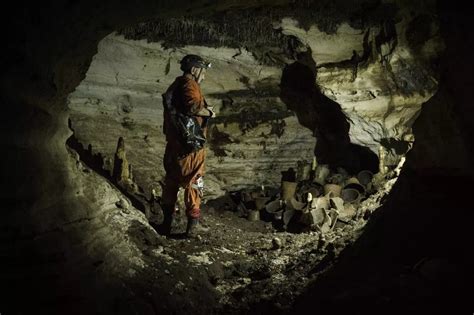
A remote cave system in Mexico has revealed a treasure trove of artifacts, including pottery shards, textile fragments, and seeds, discarded centuries ago by a pre-Hispanic civilization, offering unprecedented insights into their daily lives and cultural practices.
Archaeologists have meticulously excavated a “pristine” trash heap, undisturbed for potentially a thousand years, deep within the cave located in the northeastern Mexican state of Tamaulipas. The find promises to shed light on a little-understood culture that inhabited the region long before European contact. Researchers believe the discarded materials represent a snapshot of daily life, offering details about the civilization’s diet, clothing, and craft techniques.
The artifacts were discovered in a cave system near the municipality of Tula, not to be confused with the more well-known Tula in the state of Hidalgo, which was a major Toltec center. This Tula, nestled in the Sierra Madre Oriental mountains, served as a refuge and possibly a long-term settlement for an indigenous group whose identity is still being researched. The arid climate within the cave naturally preserved the organic materials, protecting them from decomposition and the ravages of time.
“The preservation is incredible,” stated archaeologist Martha García, lead researcher on the project, during a press conference held earlier this week. “We’ve found everything from fragments of woven baskets to remnants of their meals. It’s like stepping back in time.”
The team, composed of researchers from the National Institute of Anthropology and History (INAH), has been working at the site for several years, painstakingly documenting and analyzing the recovered materials. Their findings are gradually painting a more complete picture of this enigmatic society.
One of the most significant aspects of the discovery is the sheer quantity and variety of organic materials recovered. Unlike stone tools or pottery, which often survive for extended periods, textiles, seeds, and other perishable items rarely last more than a few centuries in open-air environments. The dry, stable conditions inside the cave provided a unique environment for their preservation.
Among the most intriguing finds are fragments of woven textiles, dyed with natural pigments. Analysis of these fragments may reveal details about the sophistication of the civilization’s weaving techniques, the sources of their dyes, and the social significance of different patterns and colors. Similarly, the recovered seeds and plant remains offer insights into their agricultural practices, dietary staples, and knowledge of local flora.
The pottery shards, while less fragile than the organic materials, are also providing valuable information. By analyzing the style, composition, and decoration of the pottery, archaeologists can gain insights into the civilization’s trade networks, artistic traditions, and cultural influences.
“We are meticulously cataloging every piece,” explains Dr. Ramirez, a ceramic specialist involved in the project. “Even seemingly insignificant fragments can provide crucial clues about their origins and relationships with other cultures.”
The discovery is particularly significant because very little is known about the pre-Hispanic cultures that inhabited northeastern Mexico. Unlike the Maya, Aztec, and other major civilizations of Mesoamerica, the groups in this region left behind few monumental structures or written records. As a result, archaeologists have had to rely on limited archaeological evidence and early colonial accounts to reconstruct their history.
The cave find offers a rare opportunity to fill in some of the gaps in our knowledge. By studying the artifacts, archaeologists can gain a better understanding of the civilization’s economic activities, social organization, religious beliefs, and daily routines.
The research team is also conducting radiocarbon dating of the organic materials to determine their age. Preliminary results suggest that the cave was occupied intermittently over a period of several centuries, possibly from around 800 AD to 1600 AD. This timeline places the civilization in the Late Classic and Postclassic periods of Mesoamerican history, a time of significant cultural and political change.
“The dating will help us to understand how this civilization evolved over time and how it interacted with other cultures in the region,” says García. “It will also help us to place them in the broader context of Mesoamerican history.”
The discovery of the trash heap also raises important questions about the civilization’s relationship with the cave environment. Why did they choose to dispose of their waste in this particular location? Was the cave considered sacred, or was it simply a convenient place to dump unwanted materials?
The answers to these questions may provide further insights into the civilization’s beliefs and practices. Archaeologists are also exploring the possibility that the cave served as more than just a garbage dump. It may have been a place where rituals were performed or where valuable objects were stored.
The excavation of the cave is still ongoing, and the research team expects to uncover many more artifacts in the coming years. They are also working to protect the site from looting and vandalism. The location of the cave is being kept secret to prevent unauthorized access.
“We are committed to preserving this valuable cultural heritage for future generations,” says García. “This discovery has the potential to rewrite the history of northeastern Mexico.”
The implications of this discovery extend beyond the borders of Mexico. It highlights the importance of preserving archaeological sites around the world and the potential for even seemingly mundane objects to provide valuable insights into the past.
The ongoing research promises to reveal more details about this lost civilization, and the international archaeological community is watching with great interest. The collaboration between INAH and other research institutions ensures that the findings will be thoroughly analyzed and disseminated to the public.
The discoveries within the cave also underscore the importance of interdisciplinary approaches to archaeological research. By combining the expertise of archaeologists, anthropologists, botanists, and other specialists, the research team is able to gain a more holistic understanding of the civilization that once inhabited the region.
The analysis of plant remains, for example, can provide information about the climate and environment at the time, while the study of animal bones can shed light on their hunting practices. Similarly, the examination of human remains can reveal details about their health, diet, and genetic relationships with other populations.
As the research progresses, the team hopes to identify the specific ethnic group to which the civilization belonged. They are also investigating the possibility that they were related to other indigenous groups in the region, such as the Huastec or the Chichimec.
The discovery of the trash heap is not only providing information about the past, but it is also helping to raise awareness about the importance of protecting cultural heritage. The research team is working with local communities to educate them about the significance of the site and to involve them in the preservation efforts.
“We believe that it is essential to work in partnership with local communities,” says García. “They are the guardians of this heritage, and their involvement is crucial for its long-term preservation.”
The ongoing research at the cave in Tamaulipas is a testament to the power of archaeology to uncover hidden histories and to shed light on the diverse cultures that have shaped our world. It is a reminder that even the most ordinary objects can hold extraordinary stories, waiting to be discovered and interpreted.
The meticulous work being conducted by the INAH team is contributing significantly to our understanding of pre-Hispanic Mexico and the rich tapestry of cultures that existed long before European arrival. This “ancient trash trove” is proving to be far more valuable than anyone could have imagined. It is a window into the daily lives, the challenges, and the ingenuity of a lost civilization, offering a profound connection to our shared human past. The investigation into this culture is anticipated to take several years, promising ongoing discoveries and revelations that will continue to reshape our understanding of the region’s history. The preservation efforts at the cave site are also crucial, ensuring that future generations can continue to learn from this remarkable archaeological find. The team is employing advanced techniques in documentation and conservation to protect the artifacts from further deterioration and to make them accessible for research and education.
The discovery also prompts reflection on the concept of “trash” itself. What one generation discards, another may find invaluable. This seemingly insignificant collection of refuse is now providing insights that precious artifacts alone could not. It speaks to the enduring importance of meticulous archaeological practices, reminding us that even the smallest details can hold profound historical significance. Furthermore, the cave’s environment played a pivotal role in the preservation of these organic materials, highlighting the importance of environmental factors in archaeological discoveries. This underscores the need for responsible environmental stewardship to protect such sites from climate change and other threats. The discovery in Tamaulipas is a vivid illustration of how much more there is to learn about the history of the Americas, particularly in regions that have been relatively understudied compared to the major centers of Mesoamerica. It serves as a call for increased investment in archaeological research and cultural heritage preservation across the continent. The researchers are also employing advanced imaging techniques, such as 3D scanning, to create digital models of the artifacts and the cave environment. This will allow them to study the site in greater detail and to share their findings with researchers and the public around the world. The digital models will also serve as a valuable record of the site in case of any future damage or loss.
The cultural implications of this discovery are also significant. It provides a voice to a people who have long been silent in the historical record. It allows us to connect with their daily lives, their struggles, and their achievements. It is a reminder that history is not just about kings and queens, but also about the ordinary people who lived and worked and created the world around them. This “trash trove” humanizes a lost civilization, giving us a glimpse into their unique perspective on the world. It challenges us to reconsider our assumptions about the past and to appreciate the diversity of human experience. As the research progresses, the team hopes to collaborate with local indigenous communities to incorporate their perspectives and knowledge into the interpretation of the findings. This collaborative approach will ensure that the story of this lost civilization is told in a way that is both accurate and respectful. The discovery also highlights the importance of protecting indigenous knowledge and cultural heritage. Indigenous communities often possess valuable insights into the history and environment of their regions, and their involvement is essential for successful archaeological research and preservation.
In conclusion, the discovery of the ancient trash trove in Tamaulipas is a significant event in the field of archaeology. It offers a unique opportunity to learn about a little-understood civilization and to rewrite the history of northeastern Mexico. The ongoing research promises to reveal even more fascinating details about this lost culture, and the preservation efforts will ensure that this valuable heritage is protected for future generations. This discovery serves as a reminder of the importance of archaeological research, cultural heritage preservation, and collaboration with local communities. It is a testament to the power of archaeology to uncover hidden histories and to connect us with our shared human past. Frequently Asked Questions (FAQ)
1. Where was this “ancient trash trove” discovered?
The artifacts were discovered in a remote cave system near the municipality of Tula in the northeastern Mexican state of Tamaulipas. Note that this is distinct from the more famous Tula in the state of Hidalgo. The specific location of the cave is being kept secret to prevent looting and vandalism.
2. What kinds of artifacts were found in the cave?
Archaeologists uncovered a wide array of discarded items, including pottery shards, fragments of woven textiles, seeds, plant remains, and pieces of baskets. These items provide insights into the civilization’s diet, clothing, craft techniques, and daily life.
3. How old are the artifacts found in the cave?
Preliminary radiocarbon dating suggests that the cave was occupied intermittently over a period of several centuries, possibly from around 800 AD to 1600 AD. This timeline places the civilization in the Late Classic and Postclassic periods of Mesoamerican history.
4. Why is this discovery significant?
The discovery is significant because very little is known about the pre-Hispanic cultures that inhabited northeastern Mexico. Unlike the Maya, Aztec, and other major civilizations of Mesoamerica, the groups in this region left behind few monumental structures or written records. The cave find offers a rare opportunity to fill in some of the gaps in our knowledge.
5. Who is conducting the research at the cave site?
The research team is composed of archaeologists from the National Institute of Anthropology and History (INAH) in Mexico. The team is also collaborating with other researchers and institutions to analyze the recovered materials and to protect the site from looting and vandalism.
Expanded Context and Analysis
The discovery in Tamaulipas resonates deeply within the broader context of Mesoamerican archaeology and history. Northeastern Mexico, often overshadowed by the more prominent cultures of the central highlands and the Yucatan Peninsula, has long been a region of archaeological intrigue. The relative scarcity of monumental architecture and written records has made it challenging to reconstruct the pre-Hispanic history of this area. This finding therefore represents a crucial opportunity to redress this imbalance and to bring the cultures of northeastern Mexico into sharper focus.
The preservation of organic materials is particularly noteworthy. In the humid environments that characterize much of Mesoamerica, textiles, plant remains, and other perishable items typically decompose rapidly. The arid conditions within the Tamaulipas cave created a unique microclimate that allowed these materials to survive for centuries, providing an unparalleled glimpse into the daily lives of the people who inhabited the region.
The implications of this discovery extend beyond the purely archaeological realm. By shedding light on the cultural practices, economic activities, and social organization of this lost civilization, the research has the potential to challenge existing narratives about the pre-Hispanic history of Mexico and to foster a greater appreciation for the diversity of indigenous cultures that flourished in the region.
The identification of specific ethnic affiliations remains a key challenge for the researchers. While the artifacts offer clues about the civilization’s cultural characteristics and its interactions with neighboring groups, further research is needed to determine its precise linguistic and ethnic identity. Comparative analyses of pottery styles, textile patterns, and other cultural traits may help to establish connections with other known cultures in the region, such as the Huastec or the Chichimec.
The ongoing research at the cave site underscores the importance of interdisciplinary collaboration in archaeological investigations. By bringing together experts from various fields, such as archaeology, anthropology, botany, zoology, and geology, the research team is able to gain a more comprehensive understanding of the site and its significance. The analysis of plant remains, for example, can provide insights into the local environment and the civilization’s agricultural practices, while the study of animal bones can reveal information about their hunting strategies and dietary habits.
The ethical considerations surrounding archaeological research are also paramount. The research team is committed to working in partnership with local communities to ensure that the site is protected and that the findings are interpreted in a way that is respectful of indigenous cultural heritage. This collaborative approach is essential for fostering trust and building long-term relationships with the people who have a direct stake in the preservation of their cultural heritage.
The long-term preservation of the cave site is also a major concern. The fragile nature of the artifacts and the vulnerability of the cave environment require careful management and conservation strategies. The research team is working to develop a comprehensive preservation plan that addresses the potential threats posed by looting, vandalism, climate change, and other factors.
The discovery in Tamaulipas also has broader implications for archaeological research around the world. It highlights the importance of exploring and documenting archaeological sites in understudied regions and of employing innovative techniques to preserve and analyze fragile artifacts. It also serves as a reminder that even seemingly insignificant objects can hold valuable clues about the past and that the most unexpected discoveries can often lead to profound insights into human history.
Furthermore, the analysis of the “trash” itself raises questions about how societies manage waste and the long-term consequences of those practices. In a contemporary context, the issue of waste management is a global challenge, and the study of ancient trash heaps can provide valuable insights into the environmental impacts of past civilizations. By examining the types of materials that were discarded, the methods of disposal, and the long-term effects on the environment, archaeologists can gain a better understanding of the sustainability of past societies and the lessons that can be applied to address contemporary challenges.
The discovery also underscores the importance of protecting natural environments that harbor archaeological sites. The cave environment in Tamaulipas played a crucial role in preserving the artifacts for centuries, highlighting the need for responsible environmental stewardship to protect such sites from destruction. Climate change, in particular, poses a significant threat to archaeological sites around the world, as rising temperatures and changes in precipitation patterns can accelerate the deterioration of artifacts and alter the conditions that favor their preservation.
The ongoing research at the cave site in Tamaulipas is a dynamic and evolving process. As new artifacts are uncovered and new analyses are conducted, our understanding of this lost civilization will continue to grow. The research team is committed to sharing their findings with the public through publications, presentations, and educational programs. They hope that this discovery will inspire a greater appreciation for the rich and diverse cultural heritage of Mexico and the importance of protecting archaeological sites for future generations. The digital preservation of the artifacts and the cave environment is also a crucial aspect of the research. By creating 3D models and other digital representations of the site, the researchers can ensure that the information is preserved even if the physical artifacts are damaged or lost. These digital resources can also be used for educational purposes, allowing people around the world to explore the site and learn about the lost civilization that once inhabited it.
The collaboration with local communities is also an ongoing process. The research team is working to involve local residents in the preservation efforts and to incorporate their knowledge and perspectives into the interpretation of the findings. This collaborative approach is essential for ensuring that the research benefits the community and that the cultural heritage is protected for future generations.
In conclusion, the discovery of the ancient trash trove in Tamaulipas is a remarkable event that has the potential to transform our understanding of the pre-Hispanic history of northeastern Mexico. The ongoing research promises to reveal even more fascinating details about this lost civilization, and the preservation efforts will ensure that this valuable heritage is protected for future generations. This discovery serves as a reminder of the importance of archaeological research, cultural heritage preservation, environmental stewardship, and collaboration with local communities. It is a testament to the power of archaeology to uncover hidden histories and to connect us with our shared human past.
The find emphasizes how material culture, even in the form of discarded waste, provides valuable insights into the daily lives, social structures, and environmental interactions of past societies. This discovery adds a vital chapter to the narrative of Mesoamerican history, particularly in a region often underrepresented in archaeological research. The ongoing multidisciplinary investigations promise further revelations, enriching our knowledge of pre-Hispanic civilizations and underscoring the importance of preserving cultural heritage sites for future generations. The research highlights the significance of northeastern Mexico as a dynamic cultural area, challenging previously held notions about the region’s limited historical importance compared to other areas within Mesoamerica. The discovery serves as an invitation for further archaeological exploration and investigation in this understudied region of Mexico.
Furthermore, the discovery offers a unique lens through which to examine the interplay between humans and their environment in the past. The artifacts recovered from the cave provide direct evidence of how the civilization utilized local resources, adapted to the arid climate, and managed their waste. These insights can inform contemporary discussions about sustainable practices and the challenges of environmental stewardship. The long-term preservation of the cave site is therefore not only a matter of protecting cultural heritage but also of safeguarding valuable scientific data that can contribute to our understanding of human-environment interactions over time. The meticulous documentation and analysis of the artifacts are crucial for maximizing the knowledge gained from this discovery. The research team is employing advanced techniques in dating, imaging, and materials analysis to extract every possible piece of information from the recovered items. This dedication to rigorous scientific methodology ensures that the findings are reliable and that the story of this lost civilization is told with accuracy and nuance.
The ethical dimensions of the research are also paramount. The researchers are committed to respecting the cultural heritage of the local communities and to engaging them in the interpretation and preservation of the site. This collaborative approach is essential for building trust and ensuring that the research benefits the community in a meaningful way. The discovery also raises questions about the ownership and management of cultural heritage resources. The Mexican government, through the INAH, has a responsibility to protect and preserve the site for future generations. However, it is also important to recognize the rights and interests of local communities, who have a deep connection to the land and its history. The research team is working to find a balance between these competing interests and to develop a management plan that is both effective and equitable.









